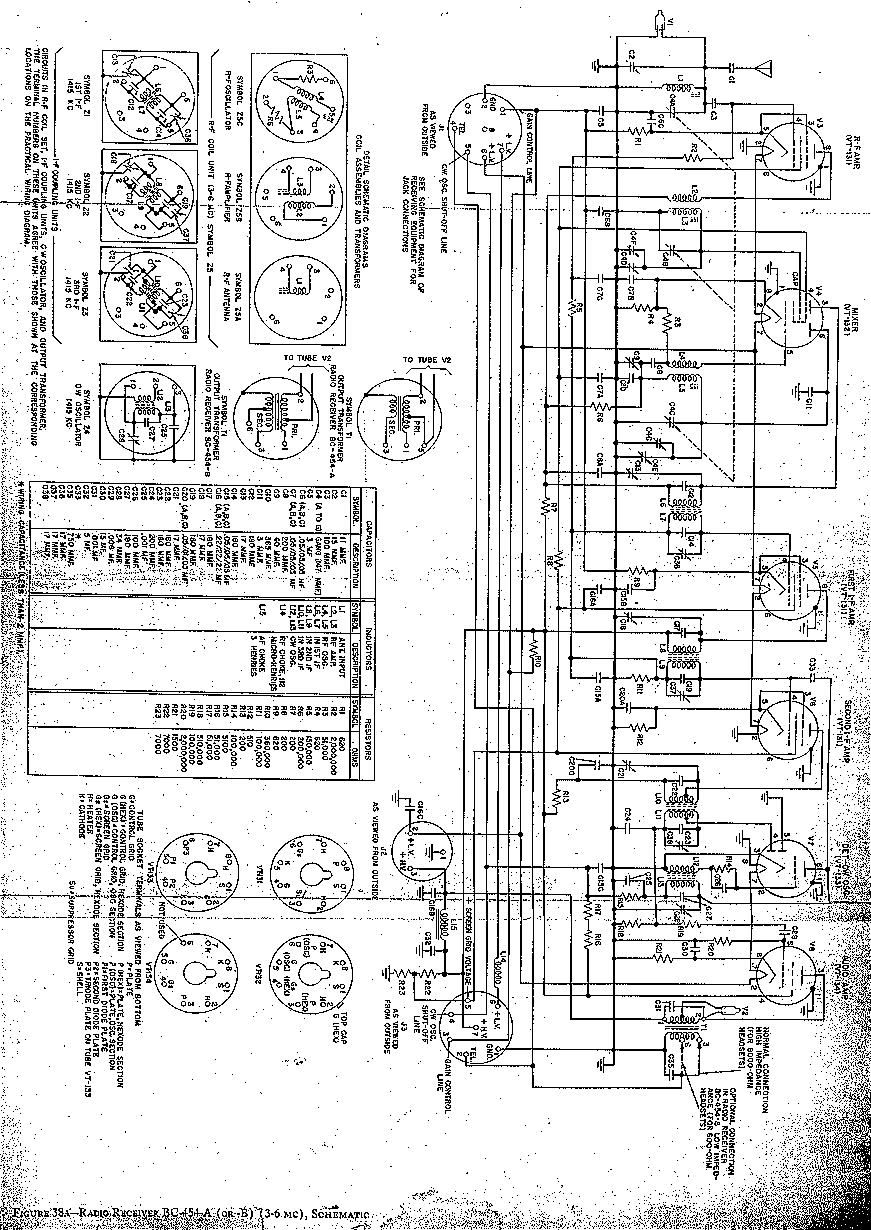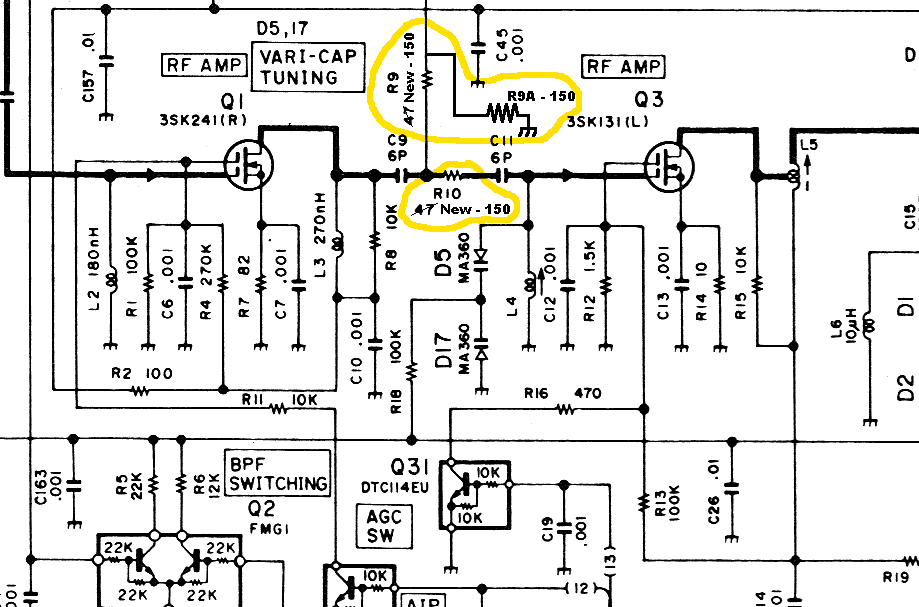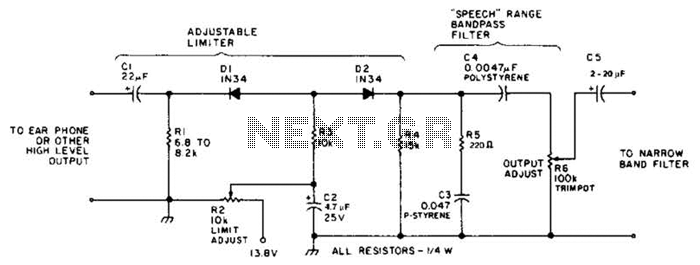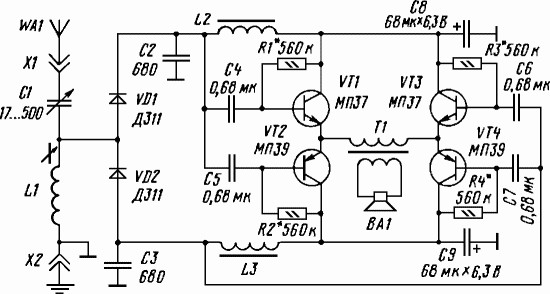
Command receivers

The Command radio refers to the radio function used for communication between aircraft rather than a specific model. The "Command" function facilitated communication within the aircraft, while the "Liaison" function was intended for communication back to base. The distinctions between these functions often became blurred, and although there were various models and generations of "Command" radios, a particular model has gained popularity as "Command sets." The Command set serves as a general term for several groups of receivers and transmitters utilized during World War II, specifically referred to as the SCR-274N (United States Army Air Force), ATA/ARA (United States Navy), and AN/ARC-5 (United States Navy). These radios facilitated Air to Air and Air to Ground communications, as well as the reception of navigation signals. Unlike most radios of that time that employed a band switch to change frequency bands, this design utilized entirely different receivers or transmitters. After the war, these radios continued to be in use; for instance, one was reconditioned for Australian civil aircraft in 1956. The SCR-274N series radios were available in black wrinkle paint or natural aluminum finish, while the Navy ARC-5 radios were only available in black wrinkle paint. Externally, they appeared identical, differing only in color and frequency coverage. Internally, they shared many similarities with minor variations related to frequency. The SCR-274N series was designated with BC-454 type names, while the ARC-5 used R-25 and T-20 type names for their receivers and transmitters. The adapter drawer on the front featured different knobs and labels for Army and Navy versions. Some low-frequency receivers had distinct antenna connections for loop aerials. The circuits were nearly identical, with only slight modifications due to frequency coverage. The valve lineup was consistent, although some ARC-5 receivers employed a 12SF7 second IF valve instead of the more common 12SK7. The construction quality of these radios was notable, with aluminum pressings, rivets, and riveted nuts used for the metal parts. Capacitors, chokes, and transformers were housed in cylindrical metal cans with mica insulators, while resistors were mounted on mica tag strips. Wiring was typically cotton-covered, sometimes with tropical proofing, and all connectors utilized mica sheets. RF coils, IF transformers, and the dynamotor were designed for plug-in operation. While they could be operated locally with a tuning knob and adapter, they were usually controlled remotely via a control box, which included electrical connections for gain adjustment and a switch for MCW/OFF/CW as well as a flexible tuning shaft for frequency selection. Modifications published in post-war magazines included adding local controls and a coaxial antenna connector, which required drilling holes in the receiver and removing certain components. Many Command sets available today have undergone such modifications, making restoration to their original condition challenging, and collectors often value original sets more highly than modified ones. This radio series is an updated version of the ATA/ARA and SCR-274N radios, serving as the primary aircraft communication radio for the US Navy during the latter part of World War II. They were installed in various bomber and fighter aircraft for intra-aircraft communication, navigation, and communication back to base. Typically, a fighter aircraft would be equipped with one receiver and one transmitter, while a bomber might have three of each. These radios were available in a black wrinkle finish, with a VHF version introduced late in the war that came in an unpainted finish. There are six LF and HF receivers: the R-23 (0.19-0.55 MHz), R-23A (0.19-0.55 MHz), and R-24 (0.52-1.5 MHz).
The Command radio sets, particularly the SCR-274N and AN/ARC-5 models, represent a significant advancement in military communication technology during World War II. These radios were engineered to provide robust and reliable communication capabilities in various operational environments, which was crucial for mission success. The design philosophy of using separate receivers and transmitters allowed for greater flexibility and efficiency, enabling simultaneous communication on different frequencies without interference.
The construction of these radios reflects the engineering standards of the time, utilizing durable materials such as aluminum for the chassis and high-quality components for reliability. The use of cylindrical metal cans for capacitors and transformers not only contributed to the robustness of the design but also facilitated ease of maintenance and repair. The cotton-covered wiring and mica insulators enhanced the durability and performance of the radios, ensuring they could withstand the rigors of military use.
Operationally, the Command radios were designed for ease of use, with features that allowed for local or remote control. The integration of a control box provided additional functionality, allowing operators to adjust gain and switch between modes without directly interacting with the radio unit. This was particularly important in combat scenarios, where quick and efficient communication could be the difference between success and failure.
The legacy of the Command radio sets extends beyond their initial deployment, as they continued to see use in civil aviation and other applications long after the war. The modifications made by users over the years reflect the adaptability of these systems, though they also pose challenges for preservation and restoration efforts. Collectors and enthusiasts often seek out unmodified units, which are considered more desirable due to their historical authenticity.
In summary, the Command radio sets exemplify the technological innovations of their time, combining functionality, durability, and ease of use to meet the demands of military communication. Their continued relevance and desirability among collectors underscore their importance in the history of aviation and military technology.The Command radio is a description of the radio function, rather than a specific model. The "Command" function was to communicate between aircraft. The "Liaison" function was to communicate back to base. However, functions often become blurred in use, and even though there were several different models and generations of "Command" radios, one pa rticular model has become popularly known as "Command sets". The Command set is a general title for several groups of receivers and transmitters used in World War 2, which are more specifically called the (United States Army Air Force) SCR-274N, (United States Navy) ATA/ARA, and the (United States Navy) AN/ARC-5. They were used for Air to Air, Air to Ground communications and for receiving Navigation signals. They are a unique design of that era, in that most radios would use a band switch to change to a different frequency band, whereas this design selects a completely different receiver or transmitter.
Here is more complete list posted by W6RIC. After the war, they were still used. I have one that was used in Australian Civil Aircraft which was reconditioned in 1956. The Army SCR-274N series radios were available in black wrinkle paint, or natural aluminium finish. The Navy ARC-5 were in black wrinkle paint. Externally they looked identical in appearance, and only differed in colour and frequency coverage. Internally they were very similar, with only minor differences, apart from the obvious ones relating to the frequency. The SCR-274N series had BC-454 type names and the ARC-5 had R-25 and T-20 type names for the receivers and the transmitters.
The adapter drawer on the front had a different knob and label for Army and Navy. Some of the low frequency receivers had a different antenna connection so that a loop aerial could be connected. The circuits were almost the same, with only a few small changes because of the frequency coverage. The valve line up was the same, except that some ARC-5 receivers used a 12SF7 second IF valve instead of the 12SK7 which was more common.
Here is a list of differences compiled by Ray Mote. They are a very nicely made radio. The metal parts are aluminium pressings, with rivets and riveted nuts. The capacitors, chokes and transformers are in cylindrical metal cans with mica insulators. The resistors are mounted on mica tag strips. The wire is a cotton covered type, sometimes with a tropical proofing. All the connectors use mica sheet. The RF coils, IF transformers, and dynamotor all plug in. They can be operated locally, using a tuning knob and an adapter. Normally, they would be remotely controlled using a control box. The control box had electrical connections for the Gain and MCW/OFF/CW switch, and a flexible tuning shaft for the frequency. There was a modification published in the post war magazines which involved adding local controls and a coaxial antenna connector.
This involved drilling holes in the receiver and removing some parts. A large percentage of the command sets available today have been modified in this way, and are difficult to restore to their original condition. Collectors will pay considerably less for modified sets as the original ones are more desirable. This series of radios is an updated version of the ATA/ARA and SCR-274N radios. They were used by the US Navy for the latter part of World War 2 and were their main aircraft communication radio.
They were fitted in many different bomber and fighter aircraft types for communication between aircraft, navigation, and communication back to base. A fighter would usually have 1 receiver and 1 transmitter fitted. A bomber would often have 3 receivers and 3 transmitters fitted. These radios were available in black wrinkle finish. A VHF version was introduced late in the war and this was available in an unpainted finish. There are six LF and HF receivers: the R-23 (0. 19-0. 55 mcs), R-23A (0. 19-0. 55 mcs), R-24 (0. 52-1. 5 m 🔗 External reference
The Command radio sets, particularly the SCR-274N and AN/ARC-5 models, represent a significant advancement in military communication technology during World War II. These radios were engineered to provide robust and reliable communication capabilities in various operational environments, which was crucial for mission success. The design philosophy of using separate receivers and transmitters allowed for greater flexibility and efficiency, enabling simultaneous communication on different frequencies without interference.
The construction of these radios reflects the engineering standards of the time, utilizing durable materials such as aluminum for the chassis and high-quality components for reliability. The use of cylindrical metal cans for capacitors and transformers not only contributed to the robustness of the design but also facilitated ease of maintenance and repair. The cotton-covered wiring and mica insulators enhanced the durability and performance of the radios, ensuring they could withstand the rigors of military use.
Operationally, the Command radios were designed for ease of use, with features that allowed for local or remote control. The integration of a control box provided additional functionality, allowing operators to adjust gain and switch between modes without directly interacting with the radio unit. This was particularly important in combat scenarios, where quick and efficient communication could be the difference between success and failure.
The legacy of the Command radio sets extends beyond their initial deployment, as they continued to see use in civil aviation and other applications long after the war. The modifications made by users over the years reflect the adaptability of these systems, though they also pose challenges for preservation and restoration efforts. Collectors and enthusiasts often seek out unmodified units, which are considered more desirable due to their historical authenticity.
In summary, the Command radio sets exemplify the technological innovations of their time, combining functionality, durability, and ease of use to meet the demands of military communication. Their continued relevance and desirability among collectors underscore their importance in the history of aviation and military technology.The Command radio is a description of the radio function, rather than a specific model. The "Command" function was to communicate between aircraft. The "Liaison" function was to communicate back to base. However, functions often become blurred in use, and even though there were several different models and generations of "Command" radios, one pa rticular model has become popularly known as "Command sets". The Command set is a general title for several groups of receivers and transmitters used in World War 2, which are more specifically called the (United States Army Air Force) SCR-274N, (United States Navy) ATA/ARA, and the (United States Navy) AN/ARC-5. They were used for Air to Air, Air to Ground communications and for receiving Navigation signals. They are a unique design of that era, in that most radios would use a band switch to change to a different frequency band, whereas this design selects a completely different receiver or transmitter.
Here is more complete list posted by W6RIC. After the war, they were still used. I have one that was used in Australian Civil Aircraft which was reconditioned in 1956. The Army SCR-274N series radios were available in black wrinkle paint, or natural aluminium finish. The Navy ARC-5 were in black wrinkle paint. Externally they looked identical in appearance, and only differed in colour and frequency coverage. Internally they were very similar, with only minor differences, apart from the obvious ones relating to the frequency. The SCR-274N series had BC-454 type names and the ARC-5 had R-25 and T-20 type names for the receivers and the transmitters.
The adapter drawer on the front had a different knob and label for Army and Navy. Some of the low frequency receivers had a different antenna connection so that a loop aerial could be connected. The circuits were almost the same, with only a few small changes because of the frequency coverage. The valve line up was the same, except that some ARC-5 receivers used a 12SF7 second IF valve instead of the 12SK7 which was more common.
Here is a list of differences compiled by Ray Mote. They are a very nicely made radio. The metal parts are aluminium pressings, with rivets and riveted nuts. The capacitors, chokes and transformers are in cylindrical metal cans with mica insulators. The resistors are mounted on mica tag strips. The wire is a cotton covered type, sometimes with a tropical proofing. All the connectors use mica sheet. The RF coils, IF transformers, and dynamotor all plug in. They can be operated locally, using a tuning knob and an adapter. Normally, they would be remotely controlled using a control box. The control box had electrical connections for the Gain and MCW/OFF/CW switch, and a flexible tuning shaft for the frequency. There was a modification published in the post war magazines which involved adding local controls and a coaxial antenna connector.
This involved drilling holes in the receiver and removing some parts. A large percentage of the command sets available today have been modified in this way, and are difficult to restore to their original condition. Collectors will pay considerably less for modified sets as the original ones are more desirable. This series of radios is an updated version of the ATA/ARA and SCR-274N radios. They were used by the US Navy for the latter part of World War 2 and were their main aircraft communication radio.
They were fitted in many different bomber and fighter aircraft types for communication between aircraft, navigation, and communication back to base. A fighter would usually have 1 receiver and 1 transmitter fitted. A bomber would often have 3 receivers and 3 transmitters fitted. These radios were available in black wrinkle finish. A VHF version was introduced late in the war and this was available in an unpainted finish. There are six LF and HF receivers: the R-23 (0. 19-0. 55 mcs), R-23A (0. 19-0. 55 mcs), R-24 (0. 52-1. 5 m 🔗 External reference





